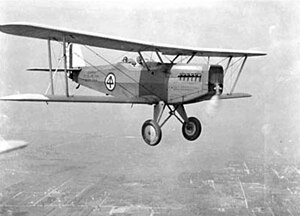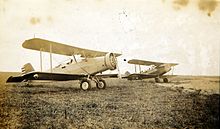
The Douglas DC-3 is a propeller-driven airliner manufactured by Douglas Aircraft Company, which had a lasting effect on the airline industry in the 1930s to 1940s and World War II. It was developed as a larger, improved 14-bed sleeper version of the Douglas DC-2. It is a low-wing metal monoplane with conventional landing gear, powered by two radial piston engines of 1,000–1,200 hp (750–890 kW). Although the DC-3s originally built for civil service had the Wright R-1820 Cyclone, later civilian DC-3s used the Pratt & Whitney R-1830 Twin Wasp engine. The DC-3 has a cruising speed of 207 mph (333 km/h), a capacity of 21 to 32 passengers or 6,000 lbs (2,700 kg) of cargo, and a range of 1,500 mi (2,400 km), and can operate from short runways.

The Curtiss Falcon was a family of military biplane aircraft built by the American aircraft manufacturer Curtiss Aeroplane and Motor Company during the 1920s. Most saw service as part of the United States Army Air Corps as observation aircraft with the designations O-1 and O-11, or as the attack aircraft designated the A-3 Falcon.

The Curtiss P-36 Hawk, also known as the Curtiss Hawk Model 75, is an American-designed and built fighter aircraft of the 1930s and 40s. A contemporary of the Hawker Hurricane and Messerschmitt Bf 109, it was one of the first of a new generation of combat aircraft—a sleek monoplane design with a retractable undercarriage making extensive use of metal in its construction.
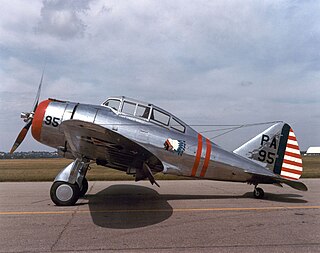
The Seversky P-35 is an American fighter aircraft built by the Seversky Aircraft Company in the late 1930s. A contemporary of the Hawker Hurricane and Messerschmitt Bf 109, the P-35 was the first single-seat fighter in United States Army Air Corps to feature all-metal construction, retractable landing gear, and an enclosed cockpit.

The Douglas Y1B-7 was a 1930s American bomber aircraft. It was the first US monoplane given the B- 'bomber' designation. The monoplane was more practical and less expensive than the biplane, and the United States Army Air Corps chose to experiment with monoplanes for this reason. At the time the XB-7 was ordered, it was being tested by Douglas Aircraft as an observational plane.

The Republic P-43 Lancer was a single-engine, all-metal, low-wing monoplane fighter aircraft built by Republic, first delivered to the United States Army Air Corps in 1940. A proposed development was the P-44 Rocket. While not a particularly outstanding fighter, the P-43A had a very good high-altitude performance coupled with an effective oxygen system. Fast and well-armed with excellent long-range capabilities, until the arrival of the Lockheed P-38 Lightning, the Lancer was the only American fighter capable of catching a Japanese Mitsubishi Ki-46 "Dinah" reconnaissance plane at the speeds and heights at which they flew. In addition, the P-43 flew many long-range, high-altitude photo recon missions until replaced by F-4/F-5 Lightnings in both the USAAF and RAAF.

The Ryan STs were a series of two seat, low-wing monoplane aircraft built in the United States by the Ryan Aeronautical Company. They were used as sport aircraft, as well as trainers by flying schools and the militaries of several countries.

The North American Aviation NA-16 was the first trainer aircraft built by North American Aviation, and was the beginning of a line of closely related North American trainer aircraft that would eventually number more than 17,000 examples, notably the T-6 Texan family.

The Boeing P-12 or Boeing F4B was an American pursuit aircraft that was operated by the United States Army Air Corps, United States Marine Corps, and United States Navy. It was the chief fighter aircraft in American service during the early 1930s but also used internationally. By the late 1930s it was replaced in front-line duty by newer designs, but it was still used for training into the early 1940s. Many variants of the aircraft were developed. In the 21st century a handful of surviving air frames are on display in museums.
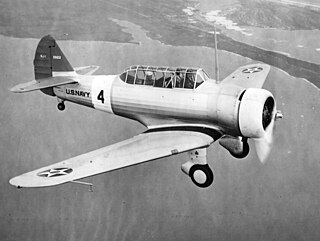
The North American BT-9 was the United States Army Air Corps (USAAC) designation for a low-wing single engine monoplane primary trainer aircraft that served before and during World War II.

The Northrop A-17, also known as the Northrop Model 8, a development of the Northrop Gamma 2F model, was a two-seat, single-engine, monoplane, attack bomber built in 1935 by the Northrop Corporation for the United States Army Air Corps. When in British Commonwealth service during World War II, the A-17 was called Nomad.
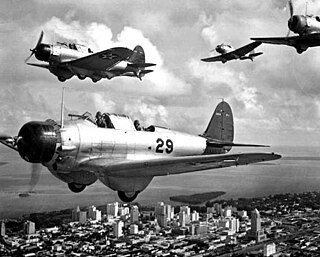
The Northrop BT was an American two-seat, single-engine monoplane dive bomber built by the Northrop Corporation for the United States Navy. At the time, Northrop was a subsidiary of the Douglas Aircraft Company. While unsuccessful in its own right, the BT was subsequently redesigned into the Douglas SBD Dauntless, which would form the backbone of the Navy's dive bomber force.

The Northrop Gamma was a single-engine all-metal monoplane cargo aircraft used in the 1930s. Towards the end of its service life, it was developed into the A-17 light bomber.

The Boeing Model 200 Monomail was an American mail plane of the early 1930s.

The Vought O2U Corsair was a 1920s biplane scout and observation aircraft. Developed by Vought Corporation, the O2U was ordered by the United States Navy (USN) in 1927. Powered by a 400 hp (298 kW) Pratt & Whitney R-1340 engine, it incorporated a steel-tube fuselage structure and a wood wing structure with fabric covering. Many were seaplanes or amphibians.

The Douglas O-31 was the Douglas Aircraft Company's first monoplane observation straight-wing aircraft used by the United States Army Air Corps.

The Consolidated O-17 Courier was an observation and training aircraft used by the United States National Guard.

The Thomas-Morse O-19 was an American observation biplane built by the Thomas-Morse Aircraft Company for the United States Army Air Corps.

The Northrop Delta was an American single-engined passenger transport aircraft of the 1930s. Closely related to Northrop's Gamma mail plane, 13 were produced by the Northrop Corporation, followed by 19 aircraft built under license by Canadian Vickers Limited.

The Waco 10/GXE/Waco O series was a range of three-seat open-cockpit biplanes built by the Advance Aircraft Company, later the Waco Aircraft Company.
